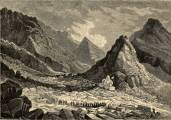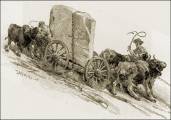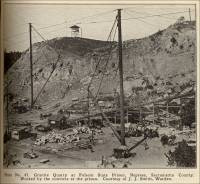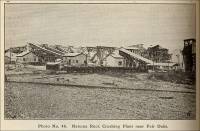


Sacramento County List of Quarries, Etc.*
(* Please note this list does not include sand or gravel quarries.)
-
Fair Oaks, Sacramento County, California - the Natomas
Consolidated Rock Crushing Plant (Crushed Rock) (Excerpt
from Report XV of the State Mineralogist, Mines and
Mineral Resources of Portions of California, Chapters of
State Mineralogist's Report Biennial Period
1915-1916, Part III. The Counties of El Dorado, Placer,
Sacramento, Yuba, California State Mining Bureau, 1919, pp.
271-459.)
"The Natomas Consolidated of California, owns a large rock crushing plant at Fair Oaks which converts dredge tailings to a commercial product...."
- Folsom, Sacramento County, California – Folsom Lake State Recreation Area – Quarry
- Folsom, Sacramento County, California– Folsom State Prison
(Also see: “Represa (near Folsom), California - Folsom State Prison” below.)
- Folsom, Sacramento County, California - Folsom Granite
Company - Excerpt from the Tenth Annual Report
of The State Mineralogist For The Year Ending December 1, 1890,
California State Mining Bureau, Sacramento: State Printing Office,
1890, pp. 513.
Sacramento County, by W. L. Watts, Assistant in the Field.
The Folsom Granite Company.
“The Folsom Granite Company has been in operation as a separate organization with concessions from the Folsom Water Power Company. They will operate extensive granite quarries, which are situated above the dam on the west side of the river. At this point (circa 1890), quarrying and dressing stone have been carried on for several years, and large quantities have been shipped to San Francisco and various other points. The stone will be brought down on scows from the quarry to the landing stage of the Folsom Water Power Railroad, which connects with the Sacramento Valley Railroad at Folsom. The water power will be used for dressing and polishing the stone.”
- Folsom, Sacramento County, California
- Folsom State Prison Quarry (Granite) - Excerpt from
the Tenth Annual Report of The State Mineralogist For The
Year Ending December 1, 1890, California State Mining
Bureau, Sacramento: State Printing Office, 1890, pp. 511.
Sacramento County, by W. L. Watts, Assistant in the Field.
The Quarry At Folsom State Prison.
“As is well known, an extensive quarry is situated within the prison grounds at Folsom. It has been opened in a granitic spur of the foothills, upon the south bank of the American River. A ledge of granite is here exposed about one thousand two hundred feet long and from fifty to four hundred and fifty men employed on these quarries, and on work in connection with the dam, canal, and power house, which are now under process of construction; of these, probably one hundred and fifty are employed in the quarry itself.
“The quarry is being worked from both the north and south ends of the ledge, and three derricks are employed to handle the stone. The south end appears to contain the best rock, it being a fine quality of syenitic granite of regular cleavage, and weighs about one hundred and seventy pounds to the cubic foot. Black Powder is principally used, also Nos. 1 and 2 Giant.
“During the year ending July 1, 1890, about thirty-five to forty thousand yards of stone were taken out for use in construction of the dam, canal, and power house upon the prison grounds, and about thirty thousand cubic yards of rubble stone were also shipped for use in Sacramento as ‘filling’ at the Southern Pacific Railroad shops at that city, and on the line of the railroad, between Sacramento and Port Costa. About five thousand feet of rough-dressed stone have also been sold. This amount has been much smaller than usual, owing to the demand for stone on the works of the canal, dam, and power house, before mentioned.
“The dam, which is built across the American River at this point, is constructed of masonry, only granite and Portland cement being used.
“From the dam, the main canal of the Folsom Water Power Company will be brought a distance of about a quarter of a mile to the power house in the grounds of the State Prison. This canal will supply the power house and State factories with power. The canal, where it leaves the dam, will be fifty feet wide at the top, thirty-five feet wide at the bottom, and eight feet deep.
“The power house will be about one hundred and sixty-six feet long, and seventy-two feet wide. A forebay will be constructed in the canal on the north side of the power house, and the water necessary to generate the power required by the prison will flow underneath the building, working six turbine wheels. The water will have a drop of seven and four tenths feet, and it is calculated to develop eight hundred horsepower. After it passes through the power house it will flow back to the canal.”
- Folsom, Sacramento County,
California - the Folsom State Prison Granite and Diorite
Quarries (From The Structural and Industrial Materials
of California, Bulletin No. 38, California, State Mining
Bureau, San Francisco, California, 1906.) Click
here to visit the Folsom State Prison web site
which presents an overview photograph of the prison.
"Folsom State Prison Granite Quarry; State of California, owner; Represa P. O.; Brainard F. Smith, clerk. In Sec. 25, T. 10 N., R. 7 E., on the east bank of the American River, one mile east of north from the town of Folsom. The quarry is operated with convict labor; the product is principally used in prison and other State construction. The macadam quarry, situate in the same quarter-section, and farther south, is described elsewhere.
"The exposure of granite on the prison lands is at the southeasterly end of the granite formation that extends in a northwest course from the northeast corner of Sacramento County to Rocklin, in Placer County. Paralleling the granite is a gray diorite, exposed in large masses in the prison macadam quarry.
"The material produced in the prison quarry is a biotite granite of good building quality that has improved with depth from 170 pounds to 178 pounds to the cubic foot. In December, 1904, the working face of the quarry had a north and south length of 300 feet, 65 feet vertical depth, and a width of 100 feet from the edge of the river bed. The granite has a regular cleavage, the dimension stone quarried averaging 2 feet by 2 feet by 6 feet; the irregular shapes of small sizes are graded as rubble rock.
"The production in 1904 was 5170 cubic feet of dimension stone and 7760 tons of rubble rock."
"Folsom State Prison Quarry; State of California, owner. In Sec. 25, T. 10 N., R. 7 E..Besides the rubble quarried with the dimension stone, there is a quarry in diorite. In 1904 the production was 63,021 tons, a small part of which was used by the prison."
-
Folsom, Sacramento County, California -
Folsom Granite Quarry (Granite) (Excerpts and photographs
from Report XV of the State Mineralogist, Mines and
Mineral Resources of Portions of California, Chapters of
State Mineralogist's Report Biennial Period
1915-1916, Part III. The Counties of El Dorado, Placer,
Sacramento, Yuba, California State Mining Bureau, 1919, pp.
271-459.)
"The Folsom Granite Quarry is situated on the east bank of the American River at Folsom State Prison. The grounds include 483.92 acres, practically all of which is made up of Granodiorite and diabase. The quarry sites are about 50 feet above the bed of the river and just east of the canal.
"Early work was carried on in diabase, the contact of which, with the granodiorite crosses the American River just north of the site of the old rock crusher. The farther this rock was quarried into the hill the deeper it was decomposed until 100' back from the river bank a 100' face shows 50' of decomposed rock. Work was also carried on in granodiorite in an old quarry just below the dam, but better rock has been opened up at the quarry now being worked just east of the prison power plant. The granodiorite is dark and medium-grained and the prison buildings built of it in 1888 show no sign of weathering. All work is done by prison labor. Equipment consists of hand and hammer drills, two derricks, and a tramway to the prison grounds. The convicts are taught to quarry, cut stone and do the masonry and some have even attempted sculptural work.
"The granite blocks have been cut for use in the prison buildings, walks, dam, canal, etc. Rip-rap is used along the canal and about 8000 tons per year is sold for railroad ballast.
"Owned by the Folsom State Prison, J. J. Smith, warden, Represa, California."
Bibliography for Sacramento County stone industry:
California State Mineralogist, Reports on Mines: VIII, pp. 556-7, 1888; X. pp. 496-514, 1890; XI, pp. 334-336, 1892; XII. pp. 225-227, 1894; XIII, pp. 316-318, 1895-6; Bulletins: No. 38, Structural and Industrial Materials, pp. 47, 48, 225, 253, 320, 362-4, 370, 1906.
Photo No. 47. Granite Quarry at Folsom State Prison, Represa, Sacramento. Worked by the convicts at the prison. Courtesy of J. J. Smith, Warden. 
- Folsom, Sacramento County, California– Rock Quarry, Folsom, State Prison (postcard photograph, No. 21; early 1900s; unmailed)
- Folsom, Sacramento County, California -
Folsom State Prison and Power House (postcard photograph;
unmailed). Caption on photograph reads: "State Prison and
Power House, Folsom, Sacramento, County."

- Folsom, Sacramento County, California
- Folsom State Prison (circa 1887) (Excerpt from Appendix
To The Journals of The Senate and Assembly of The Twenty-Seventh
Session of The Legislature of the State of California,
Vol. VII, Sacramento: State Office, P. L. Shoaff, Supt. State
Printing, 1887, pp. 127.)
“There are 479 prisoners on the register of the prison at this date (circa 1887). They are employed in the granite quarries in the prison yard, and in the improvement of the prison tract; and also in the various occupations needed for the carrying on of a prison. For the offices and stores, messengers, bed makers, and hospital, 20; invalids or incapables, 15; tailor shop, 6; shoe shop, 2; butcher shop, 1; carpenter shop, 7; tin shop, 3; blacksmith shop, 17; wagon and repair shop, 2; paint shop, 4; plumbers, 2; engineer department 12; gas house, stable, wood sawyers, wood carriers, sweepers, general help in prison, cell tenders, whitewashers, officers’ dining-room and kitchen, prisoners’ dining-rooms and kitchens, gardeners, freight handlers, water carriers, lamplighters, teamsters, night cooks, gate tenders, 113; laundry, 12; barbers, rope-room, riggers, wood choppers, ox drivers, graders, tool carriers, 37; wall builders, 5; stone-cutters, 30; rough dressers, 30; derrick men, 20;quarrymen and shovelers, 141. There are none unemployed, except those noted as in ‘invalids or incapables,’ and these are men who are crippled, or of unsound mind, or convalescing patients. There are but two in the hospital, and one is the nurse. The prisoners labor diligently, and show an interest in their work. Every man who is able to work is employed; the one female prisoner is also employed in the Turnkey’s office and as seamstress.
“This system, which is called the contract or proposition system, does an injury to both workingmen and manufacturers.”
- Folsom, Sacramento County,
California - Folsom State Prison (From Geologic
Guidebook of the San Francisco Bay Counties: History,
Landscape, Geology, Fossils, Minerals, Industry, and Routes
to Travel, Bulletin 154, Olaf P. Jenkins, Chief,
California Division of Mines, San Francisco, California,
December, 1951. Used with permission, California Department
of Conservation, California Geological Survey.) Visit these
web sites for more photographs of Folsom State Prison that
include the use of Folsom Prison Quarry Granite: (1) Folsom
Prison Entrance, presented on the Creative Services
Photograph web site; (2) Folsom
Prison photographs available in the California State
Archives; (3) View
of Folsom Prison Granite Wall entitled, "Security
fence," presented
on the web site "Prison Scene," by Herman Krieger (scroll
down to photo); (4) Folsom
State Prison,
presented by Wikipedia.
"The earliest stone building in San Francisco was constructed in 1854; dressed granite from china was used. Soon after this, granite from Folsom came on the market."
"The heaviest and steadiest producer has been the Folsom State Prison where granite dimension stone, riprap, and crushed granite have been produced by prison labor for many years. Much of the granite dimension stone has gone into prison construction, but from 1888-90 Folsom Prison furnished the rock for the construction at Folsom of a dam, canal, and first electric-power plant in central California, Riprap, rubble, and ballast from the prison quarry once were used extensively by the Southern Pacific Railroad."
- Folsom / Represa, Sacramento County, California – Folsom State Prison Quarry & Buildings (The following photographs are from Folsom Prison Calendar 1986 – Historical Photographs, produced as a project of the Vocational Graphic Arts Class at Folsom State Prison, Robert F. Gregory and Thomas T. Whitney, Instructors. The photographs and text below from the Folsom Prison Calendar 1986 – Historical Photographs are used courtesy of the California Department of Corrections and Rehabilitation. You can view part of the Folsom Prison Calendar 1986 – Historical Photographs on our web site.)
- Folsom / Represa, Sacramento County, California - Folsom State Prison Granite Quarry (Granite) Provided granite for the prison. (The Structural and Industrial Materials of California, Bulletin No. 38, San Francisco, California, 1906.) The photographs below were taken of the prison museum and walls a few years ago circa 2003.
- Folsom / Represa, Sacramento County, California – Folsom
State Prison (Present-Day)
According to the Folsom State Prison web site: The Folsom Museum is located near the entrance of Folsom Prison. Run solely through the support of volunteers, the museum contains an abundance of documents and artifacts from throughout Folsom’s long and colorful history.”
- Folsom State Prison & the Retired Correctional Peace Officers Museum at Folsom State Prison Museum – Includes photographs and a video on the history and attraction of Folsom State Prison. Also included is an interview with Jim Brown, the Curator of the Museum.
- Sacramento County, California - Sandstone Quarry near
the Cosumnes River (circa 1890) - Excerpt from the Tenth
Annual Report of The State Mineralogist For The Year Ending
December 1, 1890, California State Mining Bureau, Sacramento:
State Printing Office, 1890, pp. 510.
Sacramento County, by W. L. Watts, Assistant in the Field.
Sandstone.
“A sandstone has of late been used for building purposes taken from a point about one mile above the wire bridge on the Cosumnes River in T. 8 N., R. 8 E. This quarry was opened by parties in an early day and the stone used for trimming the Court House in Sacramento, and for several other buildings in that city. About thirty-five years ago a house was built of it near the quarry, which is still in a state of good preservation.
“The formation appears to be a remnant of sedimentary rocks that are prominent in Amador County, the connection between the two through Sacramento having been eroded. Recently (circa 1890) this stone has been made use of in the construction of the building now occupied by the Post Office at Sacramento.”
- Sacramento Valley, California – Dressing Granite for Buildings in Sacramento Valley (from “Sacramento Valley and Foothill Counties of California,” An Illustrated description of all the Counties Embraced in this Richly Productive Geographical Subdivision of the Golden State, Compiled and Edited by Emmett Phillips and John H. Miller, Published Under Direction of The Sacramento Valley Expositions Commission, J. A. Filcher, Director-in-Chief, January 1915, pp. 22 This book is available on Google Book Search – Full View Books.)
Commercial use of material within this site is strictly prohibited. It is not to be captured, reworked, and placed inside another web site ©. All rights reserved. Peggy B. and George (Pat) Perazzo.












